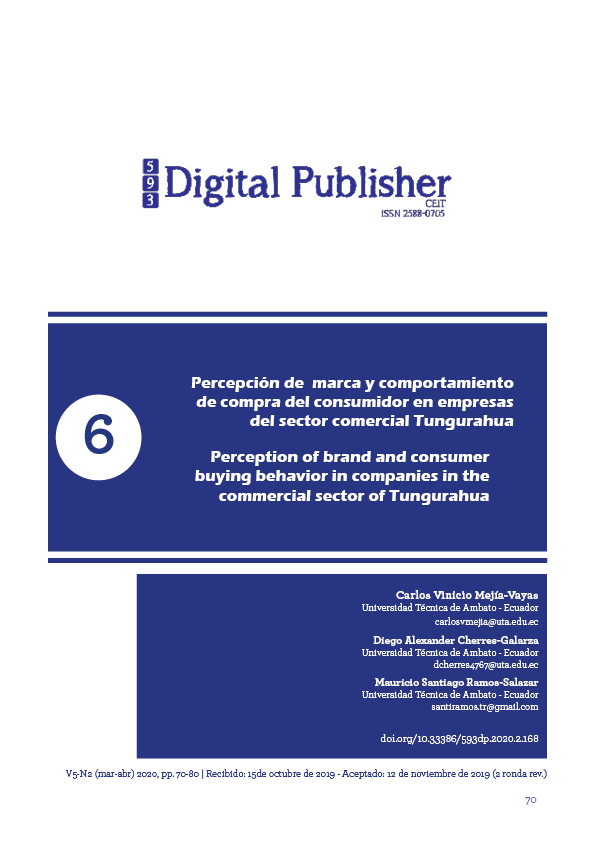Perception of brand and consumer buying behavior in companies in the commercial sector of Tungurahua
Main Article Content
Abstract
Many times consumers are emotionally influenced to buy, all of that is because some brands can come to represent the beliefs of a culture and this would collaborate in a positive way because it would be a commercial advantage over the competition which will help to stand out in the market largely, when making a purchase, there are many aspects that may be of vital importance to the customer or consumer, because at the time of doing the purchase, it tends to realize if the benefits are higher than the Price the brand perception is the process wich customers organize and interpret the stimulus generated by a name, term, sign, symbol, design or a combination of them, that is linked and superimposed in an inseparable way to a product or service in order to create a meaningful and coherent image of the world which shows a parallel with the brand's image in the methodology will be used a quantitative study or approach because will be determined numerical results that will be the result of the application of a quiz and also will use qualitative approach because through this istrument, will be developed a data collection instrument that It will applied to the consumers or clients of the different companies of the commercial sector of the province of Tungurahua to obtain results clear and reflect confidence in the study or research.
Downloads
Article Details
1. Derechos de autor
Las obras que se publican en 593 Digital Publisher CEIT están sujetas a los siguientes términos:
1.1. 593 Digital Publisher CEIT, conserva los derechos patrimoniales (copyright) de las obras publicadas, favorece y permite la reutilización de las mismas bajo la licencia Licencia Creative Commons 4.0 de Reconocimiento-NoComercial-CompartirIgual 4.0, por lo cual se pueden copiar, usar, difundir, transmitir y exponer públicamente, siempre que:
1.1.a. Se cite la autoría y fuente original de su publicación (revista, editorial, URL).
1.1.b. No se usen para fines comerciales u onerosos.
1.1.c. Se mencione la existencia y especificaciones de esta licencia de uso.
References
Ávalos, C. (2013). La marca: identidad y estrategia. Austral Comunicación, 2(1), 166-171.
Briceño, M. (2013). La Percepción Visual de los Objetos del Espacio Urbano. Análisis del Sector El Llano del Area. Revista Venezolana de Sociología y Antropología, 12(33), 84-101.
Costa, J. ( 2010). La marca creación, diseño y gestión. México: Trillas.
Cueva, R. A. (2002). Comportamiento de consumidor. México: McGraw-Hill.
Esteban, J. A. (2012). Comportamiento del consumidor. México D.F.: Alfaomega Grupo Editorial.
Fierro, Á., & Fierro, F. (2015). Contabilidad general: con enfoque NIFF para las pymes. Bogotá: Ecoe.
Hernani, M. (2008). Percepción de la personalidad de una marca global y de valores: un estudio comparativo entre consumidores brasileños y peruanos. Revista del Departamento Acádemico de Ciencias Administrativas , 12.
Hoyer, W. D., Maclnnis, D. J., & Pieters, R. (2015). Cpmportamiento del consumidor . México D.F.: Learning editores.
INEC. (2019). Boletín Técnico: Directorio de Empresas y Establecimientos. Quito: INEC.
IsabelBuilCarrasco, Salinas, E., & Montaner, T. (2007). El comportamiento del consumidor ante la promoción de ventas y la marca de distribuidor. Universia Business Review, 14.
LANZA, A. B., CASIELLES, R. V., & ARGÜELLES, V. I. (2002). El valor de marca: perspectivas de análisis y criterios de estimación. Cuadernos de Gestión , 16.
Medina, M. I., Quintero, M. d., & Valdez, J. C. (2013). EL ENFOQUE MIXTO DE INVESTIGACIÓN EN LOS ESTUDIOS FISCALES. TLATEMOANI Revista Académica de Investigación, 25.
Morán, G. C. (2018). ESTRATEGIAS DE POSICIONAMIENTO, BRANDING Y PROMOCIÓN ONLINE. Observatorio de la Economía Latinoamericana , 7.
Oviedo, G. (2004). La definición del concepto de percepción en psicología con base en la Teoría Gestalt. Revista de Estudios Sociales, 1(18), 89-96.
Polo, J., Zambrano, M., Muñoz, A., & Velilla, J. (2016). Inteligencia emocional y percepción de las emociones básicas como un probable factor contribuyente al mejoramiento del rendimiento en las ventas: Una investigación teórica. Universitas Psychologica, 15(2), 73-86.
Reynolds, L. (2013). Percepciones y preferencias del consumidor de palmito fresco. Caso: unión de asociaciones de productores de plantines y palmito. Perspectivas, 1(32), 61-104.
Salazar, J., Montero, M., Muñoz, M., & Sánchez, C. (2012). Percepción social. México: Trillas.
Salinas, E. M., Gutiérrez, T. M., & Pérez, J. M. (2007). ESTRATEGIA DE PROMOCIÓN E IMAGEN DE MARCA: INFLUENCIA DEL TIPO DE PROMOCIÓN, DE LA NOTORIEDAD DE LA MARCA Y DE LA CONGRUENCIA DE BENEFICIOS. Española de Investigación de Marketing ESIC, 26.
Salomon, M. (2013). Comportamiento del consumidor . México: Pearson Education .
Saltos, J., León, A., & Ginzález, L. (2017). La identidad de marca desde el criterio del consumidor ecuatoriano. Revista Publicando, 11(2), 463-479.
Sánchez, A., Roselló, J., & Munar, E. (2014). Atención y ercepción. Madrid: Alianza Editorial.
Sancho, E. (2016). Crear la marca global. Madrid: ESIC.
Schiffman, L., & Wisenblit, J. (2015). Comportamiento del consumidor. México: Pearson Education .
Valpuesta, M. S. (2017). MDD M arcas del distribuidor. Madrid: ESIC.
Vásquez, M., & Madrigal, R. (2012). Comercio internacional. México: Patria.

